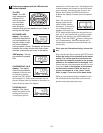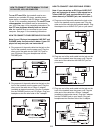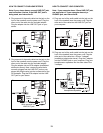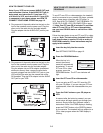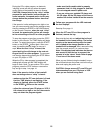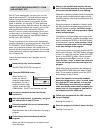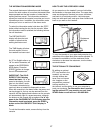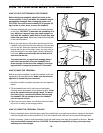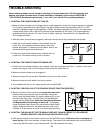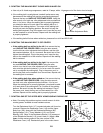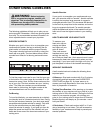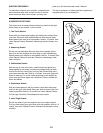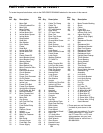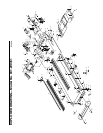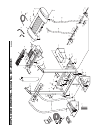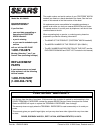
CONDITIONING GUIDELINES
The following guidelines will help you to plan your ex-
ercise program. RememberÑthese are general guide-
lines only. For more detailed exercise information, ob-
tain a reputable book or consult your physician.
EXERCISE INTENSITY
Whether your goal is to burn fat or to strengthen your
cardiovascular system, the key to achieving the de-
sired results is to exercise with the proper intensity.
The proper intensity level can be found by using your
heart rate as a guide. The chart below shows recom-
mended heart rates for fat burning and aerobic exer-
cise.
To find the proper heart rate for you, first find your age
at the bottom of the chart (ages are rounded off to the
nearest ten years). Next, find the three numbers at the
top of your age. The three numbers are your Òtraining
zone.Ó The lower two numbers are recommended
heart rates for fat burning; the higher number is the
recommended heart rate for aerobic exercise.
Fat Burning
To burn fat effectively, you must exercise at a relatively
low intensity level for a sustained period of time. During
the first few minutes of exercise, your body uses easily
accessible carbohydrate calories for energy. Only after
the first few minutes does your body begin to use
stored fat calories for energy. If your goal is to burn fat,
adjust the speed and incline of the treadmill until your
heart rate is near one of the lower two numbers in your
training zone.
Aerobic Exercise
If your goal is to strengthen your cardiovascular sys-
tem, your exercise must be Òaerobic.Ó Aerobic exercise
is activity that requires large amounts of oxygen for
prolonged periods of time. This increases the demand
on the heart to pump blood to the muscles, and on the
lungs to oxygenate the blood. For aerobic exercise,
adjust the speed and incline of the treadmill until your
heart rate is near the highest number in your training
zone.
HOW TO MEASURE YOUR HEART RATE
To measure your
heart rate, stop ex-
ercising and place
two fingers on your
wrist as shown.
Take a six-second
heartbeat count, and
multiply the result by
ten to find your heart rate. (A six-second count is used
because your heart rate drops quickly when you stop
exercising.) If your heart rate is too high or too low, ad-
just the speed or incline of the treadmill accordingly.
WORKOUT GUIDELINES
A well-rounded workout includes the following three
important parts:
A Warm-upÑStart each workout with 5 to 10 minutes
of stretching and light exercise (see SUGGESTED
STRETCHES on page 22). A proper warm-up in-
creases your body temperature, heart rate, and circu-
lation in preparation for exercise.
Training Zone ExerciseÑAfter warming up, increase
the intensity of your exercise until your pulse is in your
training zone for 20 to 60 minutes. (During the first few
weeks of your exercise program, do not keep your
pulse in your training zone for longer than 20 minutes.)
Breathe regularly and deeply as you exerciseÑnever
hold your breath.
A Cool-downÑFinish each workout with 5 to 10 min-
utes of stretching to cool down. This will increase the
flexibility of your muscles and will help to prevent post-
exercise problems.
WARNING: Before beginning
this or any exercise program, consult your
physician. This is especially important for in-
dividuals over the age of 35 or individuals
with pre-existing health problems.
21



